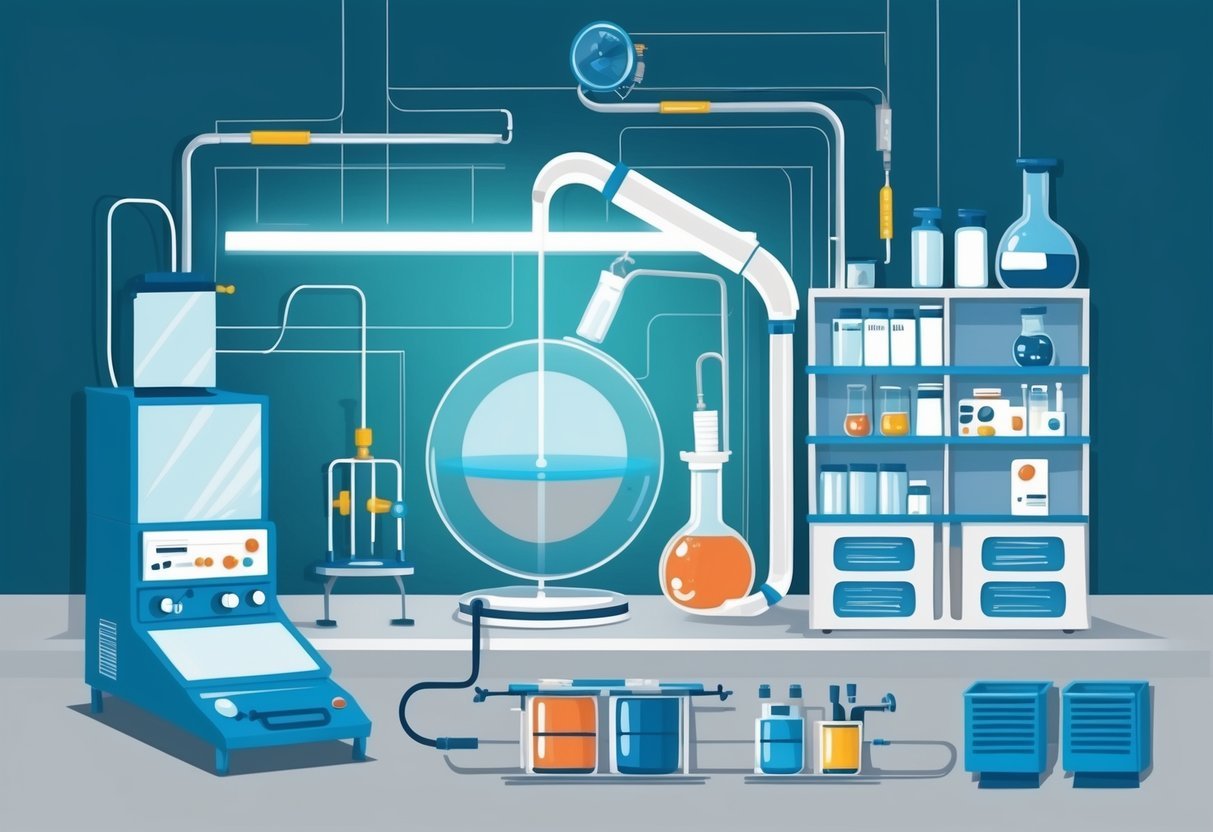Local realism is an idea in physics that seems simple but has big effects. It says things in the world are real and can only affect other things nearby. This idea made sense to many scientists for a long time.
But quantum physics showed local realism might be wrong. Experiments have proven that the universe is not locally real. This means things can affect each other instantly even when far apart. This discovery earned three scientists the Nobel Prize in Physics in 2022.
The idea that local realism isn’t true is hard to grasp. It goes against what we see in daily life. But it opens up new ways to think about how the world works. Scientists are still trying to figure out what it means for our understanding of reality.
Foundations of Local Realism
Local realism is a key idea in physics and philosophy. It deals with how objects behave and how we can know things about them. This concept has deep roots in scientific thinking.
Defining Local Realism
Local realism combines two main ideas. The first is locality. This means that objects can only be affected by things near them. The second is realism. This suggests that objects have set properties even when we’re not looking at them.
Think of a red ball. Local realism says the ball stays red even when no one sees it. It also says the ball can’t change color because of something far away.
Quantum theory seems to challenge local realism. This has led to big debates in physics.
Historical Context: Einstein, Podolsky, and Rosen
In 1935, three famous scientists wrote a paper. They were Albert Einstein, Boris Podolsky, and Nathan Rosen. Their paper is now called the EPR paradox.
These scientists didn’t like some ideas in quantum mechanics. They thought quantum mechanics went against local realism. To show this, they came up with a thought experiment.
Their experiment involved two particles. These particles were linked in a special way. The scientists said quantum mechanics couldn’t explain how the particles behaved.
This paper started a big debate. It’s still going on today. Many experiments have tried to test local realism. Some say these tests show local realism is wrong. Others aren’t so sure.
Quantum Mechanics and Local Realism
Quantum mechanics challenges our everyday understanding of reality. It presents a view of the world that seems to clash with local realism, a concept cherished in classical physics.
The Quantum Worldview
Quantum mechanics describes a strange world at the smallest scales. In this realm, particles can be in multiple states at once, called superposition. The wavefunction represents all possible states of a quantum system.
When measured, the wavefunction “collapses” to a single state. This collapse happens instantly, no matter how far apart entangled particles are. Scientists call this spooky action at a distance.
Quantum entanglement links particles in ways that defy classical logic. Measuring one entangled particle instantly affects its partner, even if they’re far apart.
Local Realism in Quantum Theory
Local realism assumes that physical properties exist before measurement and can’t affect distant objects instantly. But quantum mechanics seems to break these rules.
Einstein and others hoped hidden variables could explain quantum oddities while keeping local realism. They thought quantum theory was incomplete.
But experiments with entangled photons have shown that local realism doesn’t hold up in the quantum world. These tests confirm quantum theory’s predictions.
The conflict between quantum mechanics and local realism remains a hot topic in physics. It forces us to rethink our basic ideas about reality and how the universe works.
Bell’s Theorem and Its Implications
Bell’s Theorem changed how we think about reality. It showed that quantum mechanics allows for strange connections between far-apart things. This led to new experiments and ideas about the nature of our world.
John S. Bell and His Influential Theory
John Stewart Bell was a physicist who came up with a clever idea in 1964. He wanted to test if hidden factors could explain quantum weirdness. His theorem showed that quantum mechanics allows instant connections between distant places.
This went against what many scientists believed. They thought things could only affect nearby objects. Bell’s work sparked a big debate about how the world really works.
His theorem used math to set limits on how things should behave if they followed “local realism”. This means objects only affect nearby things and have set properties before being measured.
Experimental Tests of Bell’s Theorem
Scientists did many tests to check Bell’s ideas. These are called Bell test experiments. They measure tiny particles to see if they act in ways Bell’s math predicted.
The experiments use things like photons (light particles). They check how these particles are connected over long distances. If the results go past a certain point, it means the world isn’t “locally real”.
Many tests have shown Bell’s predictions are right. This suggests our world is stranger than we thought. It seems that measuring one particle can instantly affect another far away.
These findings have big implications for how we understand reality. They hint at a deep connection between all things in the universe.
Exploring Nonlocality
Nonlocality challenges our everyday ideas about how the world works. It suggests that things can affect each other instantly, no matter how far apart they are.
The Concept of Nonlocality
Nonlocality means that objects can influence each other without any direct contact. This idea goes against our usual understanding of cause and effect.
In the quantum world, particles can be connected in ways that seem impossible. They can share information faster than light speed.
This odd behavior doesn’t fit with the rules we see in our daily lives. It’s as if two distant objects are somehow linked, no matter how far apart.
Scientists are still trying to figure out how nonlocality works. It’s a key part of quantum physics and how we understand the universe.
Quantum Entanglement and Spooky Action-at-a-Distance
Quantum entanglement is a special type of nonlocality. It happens when two particles become so linked that they act as one system.
Albert Einstein called this “spooky action-at-a-distance.” He thought it was too weird to be true.
When entangled particles are measured, their properties match instantly. This happens even if they’re far apart.
Scientists have done tests with human choices to prove quantum entanglement is real. These experiments show that our world isn’t as simple as we thought.
Entanglement opens up new ways to send information and make powerful computers. It’s changing how we think about space and time.
Determinism vs. Randomness
The debate between determinism and randomness is key to understanding quantum mechanics. It shapes how we view the nature of reality at its smallest scales.
Understanding Determinism in Physics
Determinism suggests that if we know the present state of a system, we can predict its future. In classical physics, this idea held strong. Scientists thought they could figure out what would happen next if they knew enough about a situation.
For example, if you drop a ball, you can predict where it will land. This works well for big objects we can see. But when it comes to tiny quantum particles, things get tricky.
Some scientists wondered if there were hidden variables that could explain quantum behavior. If we knew these variables, maybe we could predict everything.
The Role of Randomness in Quantum Mechanics
Quantum mechanics brings randomness into the picture. It says we can’t always predict exactly what will happen with quantum particles.
Instead of precise predictions, quantum mechanics gives us probabilities. It’s like rolling dice – we know the possible outcomes, but not which one we’ll get.
This randomness isn’t just about what we know. Many scientists think it’s a basic part of how nature works. Quantum particles seem to behave in truly random ways.
Random number generators use this quantum randomness. They create numbers that no one can predict, even with lots of information.
Local Theories and Hidden Variables
Local theories aim to explain quantum phenomena using hidden variables. These theories try to keep our everyday understanding of how things work. Let’s look at what hidden variables are and why they matter.
What Are Local Hidden Variables?
Local hidden variables are secret factors that some think could explain weird quantum effects. Local hidden-variable theories try to keep the idea that things only affect nearby objects.
They also say that particles have set properties before we measure them. This matches how we see the world around us work.
David Bohm came up with one famous hidden variable theory. He thought particles had exact positions and speeds we just can’t see.
These theories hope to make quantum mechanics fit with classical physics. They want to keep cause-and-effect relationships we’re used to.
Role of Hidden Variables in Physics
Hidden variables play a big part in debates about quantum mechanics. Some scientists think they could solve puzzles in quantum theory.
They hope hidden variables can explain things like:
- Why particles seem to affect each other instantly over long distances
- How particles can be in many states at once
Hidden variables might help connect quantum and classical physics. This could give us a clearer picture of how the universe works.
But experiments have challenged local realism. They show it’s hard to explain quantum effects with local hidden variables.
Still, the search goes on. Scientists keep looking for ways to understand the quantum world better.
Recent Experiments and Advances

Scientists have made big steps in testing local realism. They’ve closed gaps in old tests and used new tech to get better results. These changes help us understand quantum physics better.
Loopholes in Bell Test Experiments
Bell tests check if quantum mechanics matches how we think the world works. For a long time, these tests had problems called loopholes. These gaps left room for doubt.
One big issue was the detection loophole. Old tests missed too many particles. This could skew the results. Scientists fixed this by making better detectors.
Another problem was the locality loophole. It was hard to prove that distant parts of an experiment didn’t affect each other. To solve this, researchers used far-apart light sources.
In 2015, a team did the first loophole-free Bell test. This was a huge deal. It strongly backed up quantum mechanics.
Technological Developments in Testing Local Realism
New tech has changed how we test local realism. Better tools let scientists do more complex experiments.
Quantum computers play a big role. They can make and control quantum states better than ever. This helps in running precise tests.
The Big Bell Test was a cool new idea. It used choices made by real people to help run experiments. Over 100,000 people played an online game. Their choices helped pick settings for quantum tests.
NIST has made super accurate atomic clocks. These clocks can spot tiny time differences. This helps in doing very precise quantum experiments.
Alain Aspect and Anton Zeilinger won Nobel Prizes for their work. They helped prove that the universe isn’t locally real. Their experiments used advanced laser systems and detectors.
Challenges to Local Realism
Local realism faces serious questions from both experiments and philosophy. These challenges have pushed scientists to rethink our understanding of reality and causality at the quantum level.
Violation of Bell Inequalities
Bell tests have shown that quantum systems can violate mathematical limits set by local realism. These experiments measure correlations between distant particles that are stronger than local realism allows.
Scientists have closed many loopholes in Bell tests over the years. One tricky issue was the “freedom-of-choice” problem. This asks if particle detectors are truly making free choices.
Recent tests have used human choices to address this. They had people pick settings for detectors. Even with human input, Bell inequalities were still violated.
These results suggest nature doesn’t follow the rules we expect. It seems information can spread faster than light, or particles don’t have set properties until measured.
Philosophical Implications and Debates
The challenges to local realism spark deep debates. Some wonder if we need to give up the idea of an objective reality that exists when we’re not looking.
Others suggest human consciousness might play a special role. Maybe our minds somehow affect quantum systems when we observe them.
There’s also debate about what “realism” really means. Some say quantum mechanics is still realistic, just in a different way than we’re used to.
These puzzles push philosophers and scientists to rethink core ideas about the nature of reality. The quantum world seems to work in ways that challenge our everyday notions of cause and effect.
Local Realism and its Philosophical Standing
Local realism combines ideas about how the world works. It says things can only affect nearby objects right away. It also says objects have set properties before we measure them.
Intersection of Physics and Philosophy
Local realism brings together physics and deep thinking about reality. It links to the principle of locality, which says things only affect what’s close by. This idea feels right based on what we see every day.
But quantum science challenges local realism. It shows weird connections between far-apart things. This makes scientists and thinkers wonder about cause and effect.
The debate touches on free will too. If everything is set before we look, do we really make choices? Or does looking change things?
Future of Local Realism
Local realism faces big tests from new tech. Quantum information science is pushing the limits of what we know. It’s making us question old ideas about reality.
Some think local realism might not be true at all. Others say we just need to understand it better. Either way, it’s shaping how we see the world.
As tech gets better, we’ll learn more. We might find local realism works in some cases but not others. Or we could discover whole new ways of thinking about reality.
Impact on Science and Technology

The ideas of local realism have big effects on how we study and use quantum science. They change how we think about quantum computing and information.
Implications for Quantum Computing
Quantum computing uses weird quantum effects to solve hard problems. It turns out that local realism doesn’t work in the quantum world. This means quantum computers can do things regular computers can’t.
Quantum bits can be in many states at once. They can also affect each other instantly, no matter how far apart. This helps quantum computers tackle tricky math and science questions.
Scientists are working hard to make better quantum computers. They hope these machines will crack codes, find new medicines, and more.
Local Realism and Information Science
Local realism shapes how we think about sending and using information. In the quantum world, info can move in strange ways.
Quantum networks might send unhackable messages. They use special quantum states that change if someone tries to read them.
Scientists are also looking at how quantum info moves through time. Some think future events might affect the past in tiny ways. This could lead to new ways of processing information.
These ideas push the limits of what we know about nature. They may lead to amazing new tech we can’t even imagine yet.

